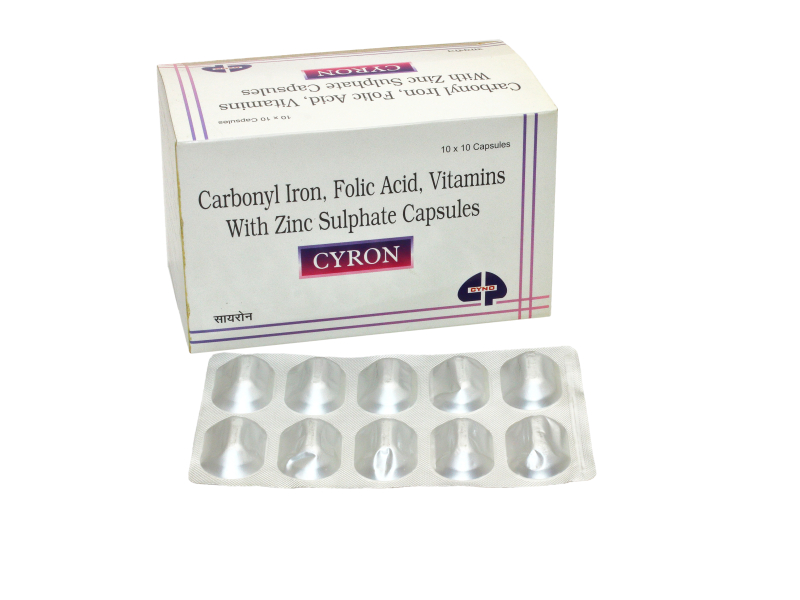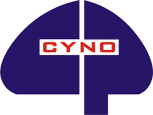CYRON
Carbonyl Iron Equ. to Elemental Iron (100 mg), Folic acid (1.5 mg), Cyanocobalamin (Vit. B12) (15 mcg), Ascorbic acid (Vit. C) (75 mg), Zinc Sulphate Mono. (61.8 mg)
Carbonyl iron is an iron replacement product. You usually take iron from the foods you eat. Iron helps your body produce red blood cells that carry oxygen through your blood to tissues and organs. Carbonyl iron is used to treat or prevent iron deficiency and iron-deficiency anemia.
Cyanocobalamin injection is used to treat and prevent vitamin B12 deficiency that can be caused by any of the following: Dangerous anemia (a natural substance deficiency required to absorb vitamin B12 from the intestine); Certain diseases, infections, or medications that reduce the number of vitamin B12 absorbed from food; Or vegetarian diet (a strict vegetarian diet that excludes any animal products, including dairy products and eggs). Vitamin B12 deficiency can cause anemia (a condition in which red blood cells do not bring enough oxygen to the organs) and permanent damage to nerves.
Cyron Capsule is used for Megaloblastic anemia due to folic acid deficiency, Treatment of anemia of nutritional origin, Pregnancy, Childhood or Vitamin B12 deficiency, Pernicious anemia, Scurvy, Cell damage, Wound healing, Wound repair, Tissue repair is. , Red blood cell production, iron deficiency, and other conditions. Caron Capsulesme is also used for purposes not listed in this medication guide.

Mechanism of Action:
Indications:
2. Iron deficiency during pregnancy and lactation
3. Iron deficiency in infants and children
2. Folic acid deficiency
3. Anaemias of pregnancy
4. Nutritional anaemia
5. Alcoholism
6. Tropical sprue
7. Non tropical sprue
2. Acne vulgaris
3. Chronic skin ulcers
4. Adjunct to antimicrobials
5. Delayed wound healing
6. Alopecia
Pharmacokinetic Properties:
Distribution: Transported in a transferrin bound form in to bone marrow for incorporation in to haemoglobin.
Metabolism: Iron liberated by destruction of haemoglobin is reused by the body.
Excretion: Excretion of iron is minimal. Loss usually occurs in nails, faeces, urine, hair, sweat, and bile.
Distribution: Widely distributed in the body and highest concentration is seen in liver. It appears in the CSF and breast milk
Metabolism: Metabolized in to N-methyl tetrahydrofolic acid in liver
Excretion: Extra drug is excreted unchanged in urine. A small portion of folate is lost by a combination of urinary and fecal excretion and oxidative cleavage of molecule.
Drug-Drug interactions:
Ascorbic acid: GI absorption of iron enhanced.
Chloramphenicol: Serum iron levels may be increased.
Cimetidine: GI absorption may be reduced.
Levodopa: Decreased levodopa serum levels.
Methyldopa: May result in decreased efficacy of methyldopa.
Quinolones: GI absorption of quinolones decreased.
Penicillamine: Marked reduction in GI absorption of penicillamine.
Tetracyclines: Decrease in the absorption of both tetracyclines and iron salts.
Food: Eggs and milk inhibit iron absorption. Administration of calcium and iron supplementation with food reduces ferrous sulfate absorption by one-third. If combined iron and calcium supplementation required then calcium carbonate should be used and the supplementation taken between meals.
2. Bronchospasm
Pencillamine: Reduced absorption of zinc.
Iron: Reduced absorption of iron and vice versa.
Precautions:
2. Minimise gastrointestinal discomfort by taking along with meals and gradually increasing the recommended dosage
3. Discontinue if intolerance occurs
4. Higher doses are required for geriatric patients
2. In pernicious anaemia and other megaloblastic where vitamin B12 is deficient
2.Renal failure
3.Biliary obstruction
Fertility:
Dosage:
Usual Adult Dose for Iron Deficiency Anemia:
50 mg orally three times a day.
Usual Pediatric Dose for Iron Deficiency Anemia:
Premature neonates:
2 to 4 mg elemental iron/kg/day divided every 12 to 24 hours (maximum daily dose = 15 mg).
Infants and children <12 years:
Prophylaxis: 1 to 2 mg elemental iron/kg/day (maximum 15 mg) in 1 to 2 divided doses.
Mild to moderate iron deficiency anemia:
3 mg elemental iron/kg/day in 1 to 2 divided doses.
Severe iron deficiency anemia:
4 to 6 mg elemental iron/kg/day in 3 divided doses.
Maintenance dosage: Half of the therapeutic dosage.
Children: 2.5 to 5mg 1 to 2 times daily.
Children: 5mg/kg 1 to 3 times daily.
Duration of action:
I.V.:3 to 6minutes
I.M.:3 to 6hours
Adverse Reaction:
Storage:
Store at room temperature, away from moisture and heat.
Overdosage:
Contraindictions:
2. Haemochromatosis
3. Haemosiderosis
4. Peptic ulcer
5. Regional enteritis
6. Ulcerative colitis
7. Those receiving repeated blood transfusions
Side effects:
2. Epigasttric distress
3. Vomiting
4. Constipation
5. Diarrhoea
6. Black stools
7. Temporary staining of teeth with liquid formulations
2. Vomiting
3. Abdominal distress
4. Gastric ulceration
5. Rashes
Warnings:
Pregnancy:
There is no information available on use of carbonyl iron during pregnancy. Consult your doctor.
Breast Feeding:
Carbonyl iron is excreted in breast milk. Consult your doctor before breastfeeding.
Old Age
